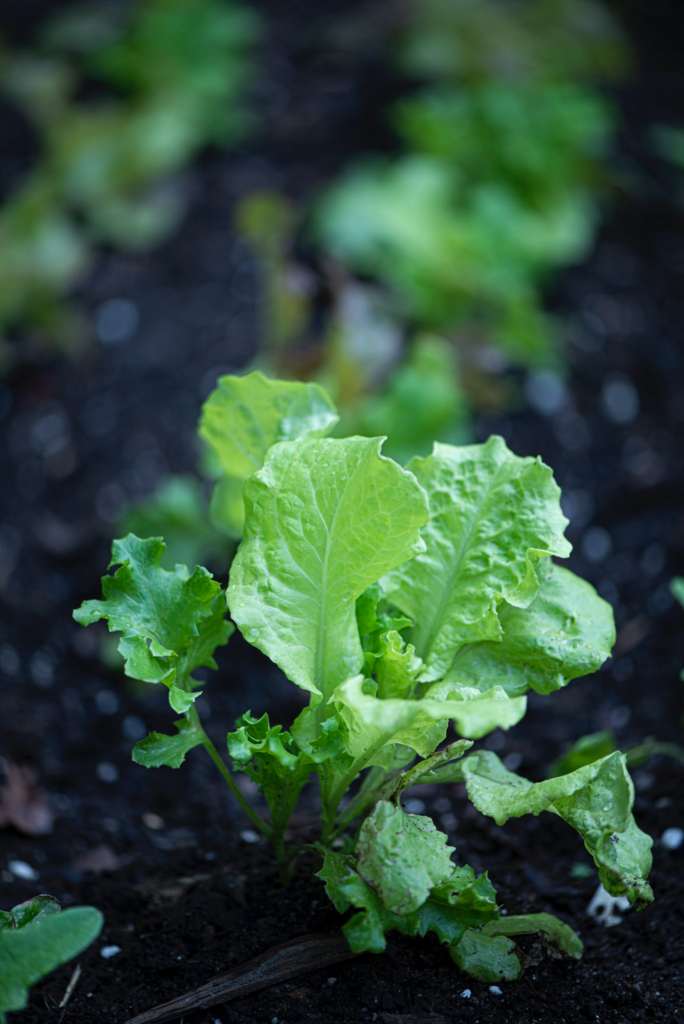Learn how to prepare your garden beds to sow spring veggies, and how to find the exact time to sow for a bountiful harvest!

Hi friends! I know many of us are waiting for our last potential frost date to plant, but did you know you could start right now? You definitely can, since so many seeds actually love the cold. Here’s what to grow in the spring garden!
Why Sow Seeds?
Through talking with people, I’ve discovered that there is a fear around seeds. The way I see it, there shouldn’t be and in fact, I highly recommend seeds because you get such a high yield! And they’re very forgiving. Let me explain. You can purchase seedlings for spinach or kale for about $2 each. You can also go to the supermarket and get a box of baby spinach for $4. Or, you can buy a packet of spinach seeds and get 50 seeds for about $2. That’s 50 plants for $2! They grow the same, if not healthier, from the seed itself since they’re not moved and their roots are not disturbed than from seedlings. You just need a little courage and trust! Anyone can sow seeds.
In fact, I taught a friend of mine about starting greens (which is what you grow in spring after all!) and after she saw how much she could grow in a small space, she was hooked! The following year, she said she’d only grow greens since they were so prolific!
I’m excited to help you get started with sowing seeds if you haven’t tried it already. If you are new to gardening, here are a few things you must consider first.

Your Last Spring Frost Date
You can easily figure out your last spring frost date by visiting this link. This is a pivotal piece of data that will inform all of your actions when it comes to sowing seeds, indoors or outdoors.
Our last Spring frost date for our area is around April 16th of this year.
Know your seeds
Now it’s time to look at the back of your seed packet. For instance, the radish packet I’m holding now says direct sow after last frost. So I know that around April 17th, I can sow my radish seeds outdoors with no problem or risk of hurting them by possible frost or snow.
That said, my spinach packet says “direct sow 3-4 weeks prior to last frost”. So I know that roughly around March 5th, I can safely sow my spinach and it should do fine with any potential light snow flurries or even frost. It’s hardy!
Prepare your soil
This is one of the most important steps in growing food and flowers: soil. It’s not dirt, friends. Dirt is what’s on the bottom of your shoes. Soil is alive, vibrant, has beneficial bacteria and microbes, living creatures, and nutrition for our plants. Every fall (or spring if you haven’t done it), we must amend our soil by adding compost and other nutritive matters.
Most people will only need compost added to their beds, and that’s how about 99% of people do it. If you want to go another level higher and become a master producer of veggies, consider worm castings and/or fish emulsion as an organic fertilizer. For instance, I’m planning on sowing some heavy feeders such as sweet peas, and they can really benefit from a handful of worm castings (essentially, worm poo) in the hole where I’m planting them. Fish emulsion is what I use to feed my plants to give them an extra bit of vitamins, but again, not necessary if you added compost. It’s just a little extra 🙂
In the spring time, as soon as the soil can be worked (is not frozen) and before you sow your seeds, look over your soil. Remove weeds but don’t disturb it too much. Disturbing the soil will actually bring up weed seeds that are lying dormant underneath. I don’t till my soil or dig it up, I simply remove weeds and add about 2 inches of compost on top.
If you want to go an extra step, I’d get a soil test. You can look up your local cooperative and find out more. Since it’s hard to gage what your soil needs, it’s a good idea to find that out professionally.

When it’s time to sow
There are so many ways to sow seeds. There is square foot gardening, no till gardening, procedures and methods for getting the highest yield. Here’s what works for me:
- Simply take your finger and draw a line in the soil, about 1/2 – 1 inch deep.
- I like to water the soil first, so that the seeds don’t wash away when overhead watering. Sprinkle in some water on that line that you just drew.
- I then sprinkle in my radishes (about an inch apart) or spinach (a little closer together), and then pinch the soil back over top using my fingers. Pat it down a bit and you’re done!
- I check the moisture of the soil over the next few days, watering about every other day if it needs it. Then I see the pop up on their own and enjoy the harvest!
What you can direct sow using this method
- Radishes
- Kale
- Collards
- Cilantro
- Spinach
- Parsley
- Peas (around St. Patrick’s Day, just soak them overnight first)
Spacing Seeds
You do want to do a little bit of research about how far to space your seeds. The basic idea is that you’ll get larger plants the farther you sow them. For instance, if you sow lettuce heavily, you’ll get spring mix. If you spread the seeds or seedlings further apart, you most likely will get a head of lettuce.
However, I don’t sow seeds far apart in the beginning because I don’t know how many seeds will germinate, and I don’t want to waste growing space waiting for them to pop. I tend to sow heavily and thin out later if they need more space. But if you only have a few seeds you want to try out, certainly space them out 5 inches apart and you won’t have to thin out later. This goes for big head items like lettuce and kale.
Enjoy The Process!
Want to try some seeds? Now’s the time, if you haven’t already done so, to check out your local farm store or supermarket that carries them. Try the cool-loving annuals such as spinach, lettuce, beets, scallions, and kale. These will teeter out by June, but you still have plenty of time left to make use of an early sowing.


Leave a Reply